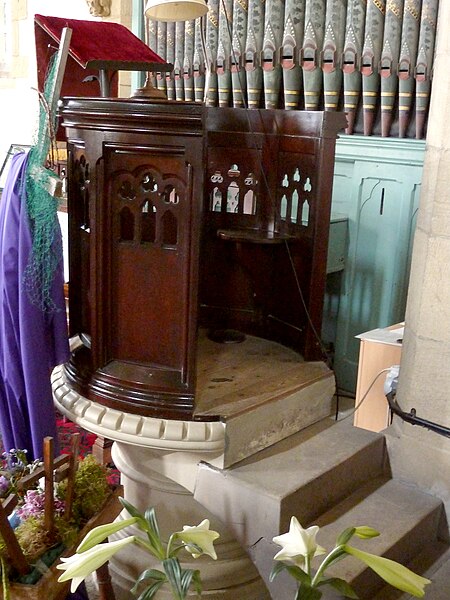A pulpit is a raised stand for preachers in a Christian church. The origin of the word is the Latin pulpitum. The traditional pulpit is raised well above the surrounding floor for audibility and visibility, accessed by steps, with sides coming to about waist height. From the late medieval period onwards, pulpits have often had a canopy known as the sounding board, tester or abat-voix above and sometimes also behind the speaker, normally in wood. Though sometimes highly decorated, this is not purely decorative, but can have a useful acoustic effect in projecting the preacher's voice to the congregation below, especially prior to the invention of modern audio equipment. Most pulpits have one or more book-stands for the preacher to rest his bible, notes or texts upon.
The pulpit of the Notre-Dame de Revel in Revel, Haute-Garonne, France
Pulpit at Blenduk Church in Semarang, Indonesia, with large sounding board and cloth antependium
"Two-decker" pulpit in an abandoned Welsh chapel, with reading desk below
1870 Gothic Revival oak pulpit, Church of St Thomas, Thurstonland
A lectern is a reading desk with a slanted top, on which documents or books are placed as support for reading aloud, as in a scripture reading, lecture, or sermon. A lectern is usually attached to a stand or affixed to some other form of support. To facilitate eye contact and improve posture when facing an audience, lecterns may have adjustable height and slant. People reading from a lectern, called lectors, generally do so while standing.
Incumbent U.S. President Gerald Ford and Jimmy Carter behind lecterns during a debate during the 1976 presidential election
A lectern in a US District Courthouse, similar to those found in academic lecture theatres
An early-twenty-first century lectern at the University of Canberra (2008)
Crucifixion panel and eagle lectern from the Siena Cathedral Pulpit, by Nicola Pisano, 1268








